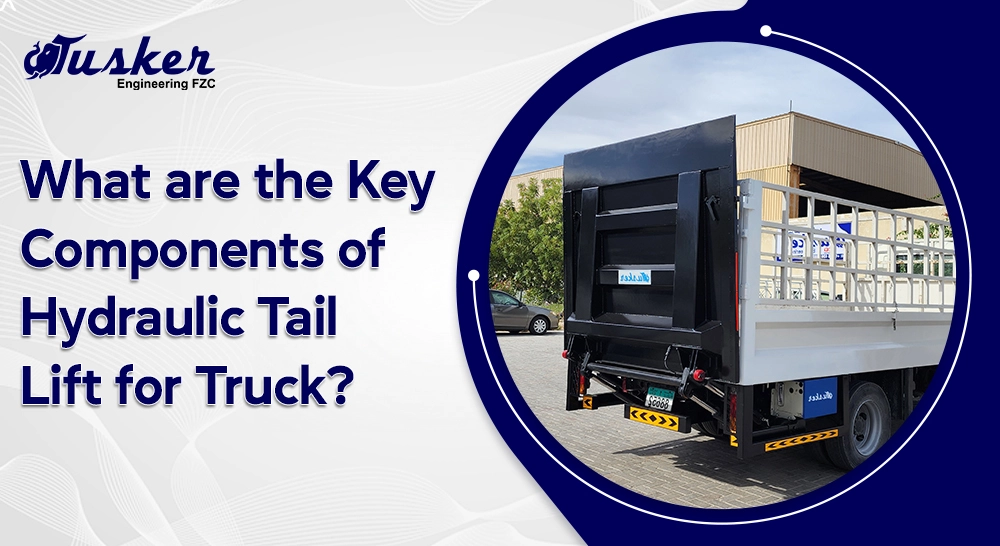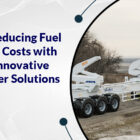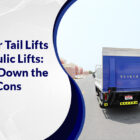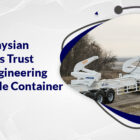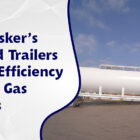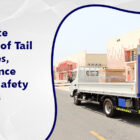Imagine you’re a truck driver preparing to unload a heavy shipment. Instead of manually lifting or using cumbersome equipment, you press a button, and a hydraulic tail lift smoothly lowers your cargo to the ground. Sounds efficient! But what exactly makes this possible?
In this interactive guide, we’ll explore the key components of a hydraulic tail lift, diving into the essential parts that make these powerful devices an invaluable tool for the logistics industry. So without further ado learn more.
An Overview of Hydraulic Tail Lift for Truck & Other Cargo Vehicles
Hydraulic tail lifts are a game-changer in the world of logistics that streamline the overall process of loading/unloading heavy and bulky cartons at ease. It is a mechanical device installed at the rear of a truck or other commercial vehicles.
Due to their hydraulic power, raising and lowering a platform not just eliminates the need for manual lifting, but eventually provides remarkable benefits of tail lift that reduces the potential risk.
In speaking of fact, according to the studies around 619 million are dealing with constant and chronic back pain complaints. Plus shockingly one-half of all compensable low back pain is triggered by manual handling tasks. To navigate such challenges and maintain a healthy work environment, one must adapt to tail lift for their tasks.
Whether you’re in logistics, transportation, or construction, get a cantilever tail lift for sale to ensure safety handling experience and boosting work efficiency.
A Quick Look at the Main Components of Hydraulic Tail Lift
The following are the main components of tail lift that contribute to the reliability and effectiveness of this revolutionary handling device across various industries. Have a look!
Hydraulic Pump: A Heart of Tail Lift
It is one of the main components of hydraulic lift that serves as the primary source of power for the entire lifting mechanism. This pump is responsible for generating hydraulic pressure by converting mechanical power into fluid pressure.
Stable Lifting Platform: A Backbone of Tail Lift
The lifting platform is not just a component but the backbone of a hydraulic tail lift. It is crucial for its functionality and reliability in cargo handling operations. The platform’s design also incorporates safety features such as non-slip surfaces and safety rails to prevent accidents during operations. Depending on the specific application and vehicle type, lift platforms come in various sizes and configurations – get in touch with an expert to buy the right tail lift for sale in UAE.
Smart Control Mechanism: A Brain of Tail Lift
The smart control mechanism can be likened to the brain of a hydraulic tail lift, reflecting its complex operations with precision and efficiency. It encompasses intuitive user interfaces such as ergonomic push-button panels or advanced remote controls that prompt ease of use till the last mile delivery.
Hydraulic Cylinder: A Oxygen of Tail Lift
Hydraulic cylinders can be likened to oxygen cylinders for a hydraulic tail lift, vital for its functional breathing. They serve as the powerhouse of the lifting mechanism, converting hydraulic pressure into robust mechanical force. Furthermore, it is important to ensure regular maintenance and inspection of hydraulic cylinders for preventing leaks, maintain optimal performance, and prolong their service life.
Power Pack: An Abs of Tail Lift
Just as the core muscles provide stability, strength, and support for overall body movement and functionality, the power pack serves as the core component that provides essential energy and control for the hydraulic lift mechanism. Typically the power pack includes components such as an electric motor, hydraulic cylinder, filters, valves, and pressure gauges.
A Sneak Peek at Other Hydraulic Tail Lift Details
This table provides a concise overview of various aspects related to hydraulic tail lifts.
| Hydraulic Tail Lift Basics | |
| Aspects | Description |
| Tail Lift Types | Cantilever (extended arms), Tuckaway, Column, Slider, Retractable |
| Tail Lift Composed Materials | Steel and Aluminium |
| Tail Lift Power Source | Electric motor, Vehicle’s PTO (Power Take-Off) |
| Tail Lift Hydraulic System | Hydraulic pump, Hydraulic cylinders, Power pack (motor, reservoir, valves) |
| Tail Lift Control Mechanism | Push-button panel, Remote control |
| Tail Lift Safety Features | Safety rails, Non-slip platform surface, Overload protection, Emergency stop button |
| Tail Lift Loading Capacity | Typically 500 kg to 3000 kg |
| Tail Lift Platform Sizes | Various sizes available to accommodate different cargo dimensions |
| Tail Lift Applications | Delivery trucks, Commercial service vehicles, Industrial vehicles |
| Tail Lift Benefits | Improved efficiency, Enhanced safety, Reduced manual labor, Adaptability to various environments, Increased productivity |
Note- The following table is for reference with the aim of providing a general insight. An actual product may vary by specific specifications.
It’s a Wrap
At Tusker Engineering, we offer different types of tail lifts designed for various applications, from delivery trucks to service vehicles and industrial settings. Our hydraulic tail lifts are engineered to optimize cargo handling processes, ensuring seamless loading activity.
As a leading tail lift manufacturer in UAE, we craft tail by using top-notch quality materials & advanced technology that guarantees durability, performance and longevity at its best. To find the right type of tail lift, Get in touch with our team for further details!

